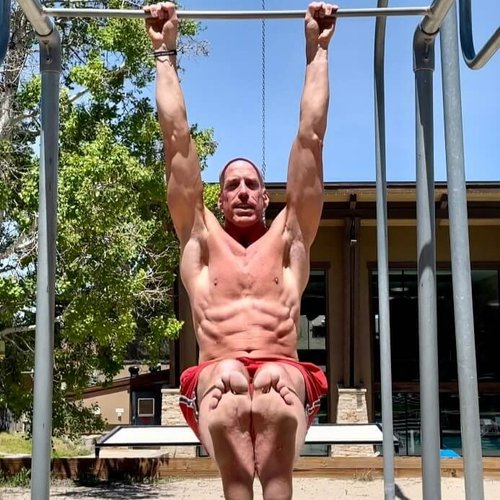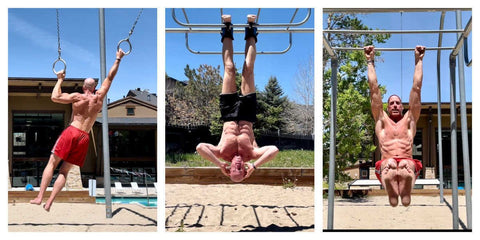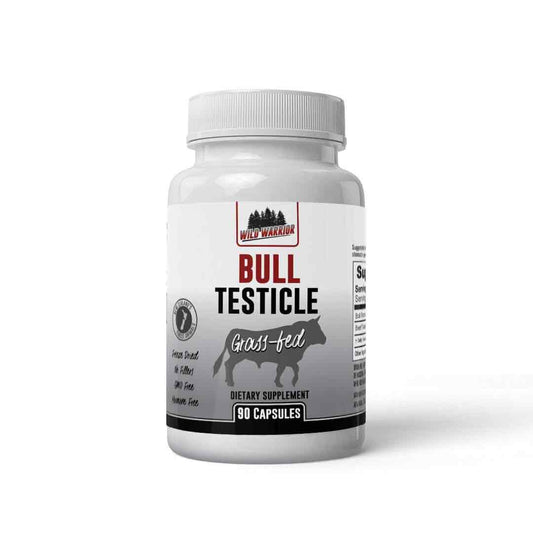Hanging is very therapeutic for your body. At Wild Warrior Nutrition, we encourage you to practice the exercise of hanging on a regular basis. Keep reading to learn more about this practice and discover the amazing benefits of three different forms of hanging exercises.
The Amazing Benefits of Hanging Exercises
What is Hanging?
Much like it sounds, hanging is suspending yourself from an object by grabbing ahold of it with your hands. Most often, a pull-up bar is utilized, but any apparatus will do. Aside from pull-ups bars, I’ve used tree branches, I-beams, L-beams, stair steps, ledges, and deck overhangs in my lifetime.
Your body doesn’t know the difference, so there is no need to split hairs. All you need to know is hanging can bring some fun variations to your workouts and be used as therapy to right some wrongs in your upper body.
Before I move forward though, I’d like to mention that I also refer to hanging as “off-the-ground training.” I think that pretty much spells it out. In classical times, this is often what it was referred to. Anything that had to do with being off the ground while performing exercises would be called off-the-ground training.
If you ever watched gymnastics, you could clearly see that there is a lot of off-the-ground training and events taking place. You might also notice how fit gymnasts are. That’s no coincidence!
Why Should You Hang?
It is my opinion, practicing a hanging posture is just as underserved as barefoot health in the world of fitness. I’ve spoken about barefoot running in the past so I’m not going to expand. But make sure to check our YouTube page for some archival videos on that. For now, the main thing you need to know is that hanging helps with posture, and here’s how.
When you sit for long periods of time, your chest muscles become tight, your rhomboids become weak, and your shoulders get rounded. Left unattended for an extended period this can have a negative impact on your physical ability. It can even cause your organs to become misaligned. That can then have a carryover effect that jacks up your entire system.
Fear not though! By hopping up and grabbing a stationary, overhead object and hanging for a mere few seconds, you can start the reparation process. Hanging helps stretch your chest, shoulders, and upper back, which helps alleviate tension you have built up and helps reverse upper body postural distortions.
Another benefit of hanging is grip strength. It may sound rudimentary, but a loss of grip strength is a very big deal, especially as you age. Daily chores can become more arduous, and this can make everything you do more challenging.
On the other side of the coin, if you are an athlete where grip is important, it can benefit you bigtime. Climbers, grapplers, boxers, mixed martial artists, and baseball players can all experience benefits from a stronger grip.
Also, while hanging and doing exercises, you are firing up the abs and obliques like you never have before. But it is done from a position that is non-threatening to your back, unlike lying on the ground, doing crunches.
Lastly, hanging is very good for shoulder injuries. Take impingement, for example. This occurs when the acromial joint starts to lose its space from sitting for long periods of time. The result is, the ligaments and tendons in this area get pinched, causing pain and discomfort.
Hanging from a bar can naturally open this space back up and take the tension off your connective tissue. The result is you reverse the pain and fix the damage that was done. In this sense, hanging would be a good example of what is known as corrective exercise.
How Do You Actually Hang?
The act of hanging is not complicated, but there are some points to take into consideration. Start by jumping up and grabbing a pull-up bar with your hands about shoulder-width apart. But remember, any object will do. For the sake of ease, we will use the pull-up bar as a reference.
Let your arms fully extend and keep your body as still as possible. Hold for 30 seconds or as long as you can. Then hop down, shake out the tension and hang again. Repeat three or four times and call it good.
Then come back later in the day and perform another round. Repeat every day and try to progress the amount of time you hang and the amount of sets you do.
Another option is to practice throughout the day and integrate your bouts of hanging. If you work from home and are lucky enough to have a pull-up bar or object to hang from, then you can go this route easily and efficiently. Plus, it will be a good refresher to your shoulders and can take the place of a stretch or movement break.
Hanging Progressions
Once you’re able to hang like a Christmas tree ornament, you can start to get fancy and turn up the volume. The first thing you can do is start performing exercises from a dead hang position.
You can perform knee raises, leg raises, windshield wipers, leg circles, alternating knee pull-ins and a host of other drills. All of these drills place a lot of tension on the abs and you can expect to make progress faster then you ever expected.
You can make these drills even harder by adding load like wearing ankle weights or pinching a medicine ball, weight plate of dumbbell between your feet or knees.
Another thing you can do while hanging is pull-ups, chin-ups, skin-the-cats, front and back levers, and dips. These are good examples of off-the-ground-training described earlier. If you become a superman or superwoman and need more load, you can wear a dipping belt with weights, a weighted vest or backpack filled with books.
Just always focus on your form and never let ego get in the way. High reps and sets of sloppy pull-ups will not make you fitter. They’ll create postural distortions and injuries that will set you backwards.
Any time you do exercises on a bar, make sure they are precise, slow and controlled, and you focus on low reps with high sets.
Type of Hanging Exercises #1: Inversion
Since we’re talking about hanging, it’s only fitting that we go down the road of inversion. This is a form of hanging, but you are upside down. I happen to love this variation because it brings several additional benefits to the body that regular hanging cannot. Here are some of the key points associated with going upside down.
Back pain relief: When you are inverted, you get a massive release in your spine. Space is created between the vertebrae, which can bring in a good amount of oxygenated blood.
This has a healing effect, and it also causes decompression. In essence, you are stretching your spinal column, which makes it more flexible and resistant to injury over time as well as relieving back pain. And not to mention, it feels amazing!
Better brain function: Inversion causes a lot of blood flow to the brain. This gives you an instant hit of clarity and cognitive function, and it can also boost your mood.
It makes sense that you might want to do this during the day while working on your computer or doing any form of work that involves a lot of brain activation.
Boosted immune system: Inversion causes your lymphatic fluid to go the other direction, which has a cleansing effect that contributes to a higher immunity.
Stronger organs: Are you aware that as you age, the connective tissue holding your organs in place starts to get lax? Well it does. And that is one of the main reasons for organ failure. To offset this threat, inversion causes the organs to go upside down, and in turn, the connective tissue that normally degrades, gets stronger.
A few words of warning about inversion. Just like hanging, start out basic and only invert for a short amount of time. Hanging for really long periods can do major damage to your eyes and the blood vessels in your head, and it can increase the pressure in your inner ears. I know this sounds extreme, but I want to make sure you do things correctly and not put yourself at risk.
Using an inversion table where your feet are locked into anchors is the easiest and safest way to invert. You can adjust them, so they only go partially back, or all the way inverted. If you simply go to a 60-degree angle, you will still get full decompression and all the benefits associated with inversion.
Gravity boots work great too but they are more hardcore. You should work your way up to them and always have a spotter on hand. I personally use the boots, but I’ve been doing this for many years and earned my way there. You can do the same.
Type of Hanging Exercises #2: Brachiation
There are a lot of people who associate hanging with brachiation. However, they are not the same. Brachiation is the act of swinging or moving from one overhead object to another. This movement is also referred to as “arm swinging.” Think in terms of monkeys as they swing from vine-to-vine or limb-to-limb.
Humans can do brachiation as well. A good example of this would be using a set of traveling rings or going from one money bar to the next. You see actions like this all the time in obstacle course races and American Ninja Warrior.
Arguably, this type of action is the hardest form of hanging because you only have one limb holding you with each movement. The additional benefits here are you get a tremendous ab workout as well as a high amount of shoulder flexibility and stability.
Before you try any type of brachiation though, I have another warning for you. Make sure your shoulders are healthy and strong to start with. You do not want to risk putting yourself into further threat if you have pre-existing injuries.
Also, brachiation really requires a lot of grip strength. If you lack it, you will only be able to go a short amount of time in the beginning before your grip gives out. But as you keep practicing, you’ll get stronger and be able to go for longer time frames.
Do some hanging first, then do some exercises while hanging so you know you can hold yourself in place for a while, and then attempt brachiation.
Final Word on Hanging Exercises
If you have never hung, inverted, or brachiated, I highly suggest you wean all three forms of exercise into your protocols right now. Start out slow, easy, and basic and work your way up from there.
It is protocols like these that are the most beneficial for your health in the long-haul. But they are also the ones that you do not hear enough about out on the streets. Remember, small actions carry big opinions. Do all the small things necessary in life and you will be fitter, straighter, stronger, and happier than ever before.
This is Kevin David Rail, follow me on IG at trainer_rail and FB at https://www.facebook.com/kevin.rail
About the Author: A Life and Career Dedicated to Healthy Living
Kevin David Rail is a fitness nutrition specialist with certifications through ACSM, ACE, NASM, ACSM, AFM and a BS in Sport Management/Fitness and Wellness. He was featured in the documentary films Fasting and The Motivation Factor for his expertise as a health and fitness professional. Kevin has helped hundreds of people change their lives through expertly designed meal plans and training programs that maximize size, strength, and fat loss.
P.S. If you have not done so yet, make sure to download the My Inferno Body app, which comes with workout and exercise libraries, pre-made programs, fasting protocols, gut health guides and a signature cookbook. All bases are covered to push your health and wellness to the next level!






